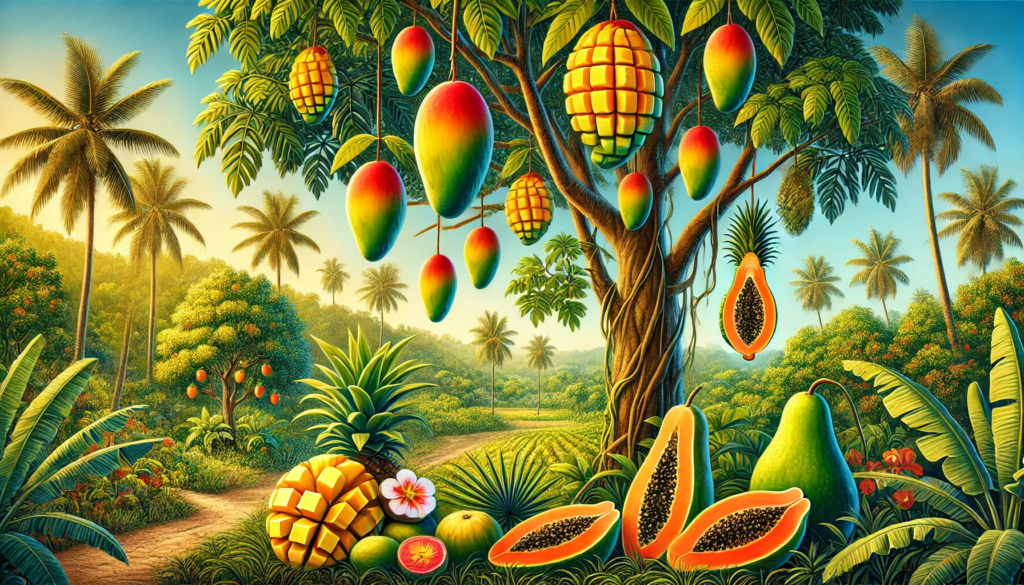The Caribbean is home to a wide variety of fruit-bearing trees, many of which play a central role in the region’s culture, cuisine, and daily life. Among the most common and cherished fruit trees in the Caribbean are mango, guava, and papaya, each offering not only delicious, tropical flavors but also deep cultural significance.
These trees have been cultivated for generations and are celebrated for their versatility in both culinary and medicinal uses.
Let’s explore these three iconic Caribbean fruit trees—their characteristics, cultural importance, and the ways in which they shape the daily rhythms of Caribbean life.
Mango (Mangifera indica)
Characteristics
The mango tree (Mangifera indica) is perhaps the most popular fruit tree in the Caribbean, known for producing juicy, flavorful mangoes that come in a variety of shapes, sizes, and colors. The tree is large and can reach heights of 30 to 40 meters, with dense, dark green foliage. Mangoes themselves are typically oval or round, with skin that ranges in color from green to yellow, red, or even purple, depending on the variety.
Mangoes have a smooth, succulent flesh that surrounds a large, fibrous seed. Their flavor can range from sweet to slightly tangy, making them a versatile ingredient in both sweet and savory dishes.
Cultural Significance
Mangoes hold a special place in Caribbean culture, symbolizing abundance and tropical richness. Mango season, which typically lasts from May to August, is eagerly anticipated by people across the islands. The fruit is often eaten fresh, peeled and sliced, but it also features in a wide array of Caribbean recipes.
Mangoes are used to make chutneys, sauces, jams, and desserts like mango sorbet or smoothies. They are also key ingredients in salads, salsas, and Caribbean-style seafood dishes, where their sweetness provides a natural balance to spicy flavors. In some parts of the Caribbean, green (unripe) mangoes are enjoyed with a sprinkle of salt and pepper, or they are pickled for a tart, refreshing snack.
Beyond the kitchen, the mango tree is also significant in traditional medicine. Mango leaves, bark, and roots are used in folk remedies to treat ailments such as digestive issues, respiratory problems, and skin conditions.
Guava (Psidium guajava)
Characteristics
Guava (Psidium guajava) is another common fruit tree found throughout the Caribbean. The guava tree is small to medium-sized, reaching heights of 3 to 10 meters, with smooth, thin bark and spreading branches. Its fruits are round or oval, with a rough outer skin that can be green, yellow, or reddish in color. Inside, guavas have a fragrant, soft flesh that varies from pale yellow to deep pink, and they contain numerous tiny seeds.
The flavor of guava is sweet, with a hint of tartness, and it is known for its strong, tropical fragrance. The fruit is often eaten fresh or used in juices, jams, and desserts.
Cultural Significance
Guava is deeply embedded in Caribbean culture, both for its culinary uses and its medicinal properties. Guava trees are often found in backyards and along roadsides, where they bear fruit year-round, though the main guava season typically occurs in the late summer and fall.
One of the most popular guava-based products in the Caribbean is guava jam or guava jelly, which is often spread on bread, pastries, or used as a filling in desserts. Guava juice is another staple, enjoyed both on its own or mixed with other tropical fruits like passion fruit and soursop.
In addition to its culinary uses, guava has long been valued for its health benefits. Guava leaves are used in traditional medicine to treat ailments such as diarrhea, infections, and digestive issues. Guava is also rich in vitamin C, making it a go-to fruit for boosting immunity.
In many Caribbean households, guava is cherished as a “fruit of the people,” readily available and affordable, and it is enjoyed by families across all walks of life.
Papaya (Carica papaya)
Characteristics
The papaya (Carica papaya), also known as pawpaw in some regions, is a fast-growing tropical tree that is widely cultivated throughout the Caribbean. Papaya trees are relatively small, growing between 5 to 10 meters tall, with a straight, single trunk that supports a canopy of large, palmate leaves. The tree produces large, oblong fruits that can weigh several pounds each. The fruits have green skin when unripe, which turns yellow or orange as they mature.
Inside, papayas contain sweet, soft, orange or pink flesh and a central cavity filled with small, black seeds. The flesh has a mild, sweet flavor, often compared to melon, while the seeds have a slightly peppery taste and are sometimes used in salad dressings or eaten for their medicinal properties.
Cultural Significance
Papaya is a versatile fruit with deep roots in Caribbean culinary traditions. It is commonly eaten fresh, sliced, or diced, often paired with lime juice to enhance its natural sweetness. In Caribbean cuisine, papaya is also used in salads, smoothies, and desserts like fruit tarts and papaya cakes.
Green papaya (unripe papaya) is widely used in savory dishes. It is grated and made into pickles or salads, or it is cooked in stews and soups, where it adds texture and a mild flavor to dishes.
In traditional medicine, papaya has long been regarded for its digestive benefits. The enzyme papain, found in papayas, aids in digestion and helps break down proteins, making papaya a popular remedy for indigestion. Additionally, the leaves of the papaya tree are used in some folk remedies to boost immunity and combat infections.
Papaya is also a symbol of health and vitality in Caribbean culture. Its wide availability and versatility make it a staple fruit in many households, contributing to the vibrant and nutritious food culture of the islands.
Conclusion
Mango, guava, and papaya are three of the most important and beloved fruit trees in the Caribbean, deeply intertwined with the region’s culture, cuisine, and natural landscape. These trees provide not only delicious fruits but also contribute to the health and well-being of Caribbean communities through their medicinal uses. Whether enjoyed fresh from the tree, incorporated into local dishes, or used in traditional remedies, these fruits are cherished for their flavor, versatility, and cultural significance.
FAQ
What are the most common fruit trees in the Caribbean?
Some of the most common fruit trees in the Caribbean include mango, guava, and papaya. These trees are widely cultivated and provide a range of delicious fruits that are central to Caribbean cuisine and culture.
How are mangoes used in Caribbean cooking?
Mangoes are used in a variety of ways in Caribbean cooking. They are eaten fresh, made into chutneys, sauces, jams, and used in desserts like sorbet and cakes. Mangoes are also used in salads, seafood dishes, and paired with spicy ingredients for a balance of sweet and savory flavors.
What is the cultural significance of guava in the Caribbean?
Guava holds cultural significance in the Caribbean as a widely available and affordable fruit. It is used in traditional dishes like guava jam, jelly, and juice, and has medicinal uses in treating digestive issues and infections. Guava is also a symbol of tropical abundance and health.
What health benefits does papaya offer?
Papaya is known for its digestive benefits, thanks to the enzyme papain, which aids in breaking down proteins. Papaya is also rich in vitamins A and C, making it a nutritious fruit for boosting immunity and supporting overall health. The seeds are also used in traditional remedies.
Can you eat green papaya?
Yes, green (unripe) papaya is often used in savory dishes in the Caribbean. It is grated and used in salads or cooked in soups and stews. Green papaya has a mild flavor and adds texture to various dishes.
When are mango, guava, and papaya in season?
Mango season typically lasts from May to August, guava is available year-round with a peak season in late summer and fall, and papaya is also available year-round, making all three fruits a constant presence in Caribbean cuisine.

